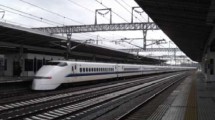Overview
- Authors:
-
-
Tetsuo Shimomae
-
Electrical Engineering, Japan Railway Electrical Engineering Association, Yotsukaido, Japan
- Birth of the world’s first high-speed railway
- Conversion of military focused technology to civilian use
- Overviews the technology of high-speed rails
Access this book
Other ways to access
About this book
This book discusses the Shinkansen, the world's first high-speed railway, which was born in Japan in 1964 and how it has developed up to the present day. In the 1950s, some European railways were trying to increase the commercial operating speed up to 160 km/h, and it was considered difficult to raise it to 200 km/h. Japanese engineers with excellent engineering ability post World War ll moved from the military to the railways to overcome the technological challenges realizing the high-speed railways using new approaches. The book discusses the technological barriers in speeding up the railway at that time and how these engineers overcame them in non-computer days. In the five decades since the Shinkansen began operating, there have been significant developments enabling high-speed, safe, and frequent train operation with high punctuality while conserving the environment. The book also describes today’s highly evolved Shinkansen. The Shinkansen, which runs 440,000 km a day, has carried 13.3 billion people without a single fatality in 56 years. The book overviews factors that contributed to the Shinkansen’s high safety record. This book is an excellent guide for those interested in the history of the world’s first high-speed railway.
Similar content being viewed by others
Table of contents (7 chapters)
-
-
The Birth of the Shinkansen
-
-
-
-
-
-
-
The Current Shinkansen
-
Front Matter
Pages 213-215
-
-
Photographs
-
Front Matter
Pages 245-245
-
-
Back Matter
Pages 293-302
Authors and Affiliations
-
Electrical Engineering, Japan Railway Electrical Engineering Association, Yotsukaido, Japan
Tetsuo Shimomae
About the author
Tetsuo Shimomae received his Master's degree in Electrical Engineering from Nagoya Institute of Technology in 1966 and joined the Japanese National Railways (JNR) the same year. In1967, he started working with the Railway Technical Research Institute (RTRI), developing an overhead catenary equipment inspection vehicle and improving the Shinkansen pantograph. In 1974, he received the Ohm Award from the Promotion Foundation for Electrical Science and Engineering. In 1987, when JNR was split into several private companies, he belonged to the JR Central Company which took over the Tokaido Shinkansen. There, he served as head of the Shinkansen division's electrical department, deputy general manager of the Engineering Department, manager of the Safety Management Department (director), and Shizuoka Branch President (managing director). After leaving the company, he served as president and chairman of Shinsei Technos Co., Ltd., a subsidiary of JR Central in charge of construction and maintenance of railway electrical equipment. In 2008, he became chairman of the Japan Railway Electrical Engineering Association whose members are railway electrical engineers, manufacturers, and associated construction companies, and has been an advisor since 2012.




